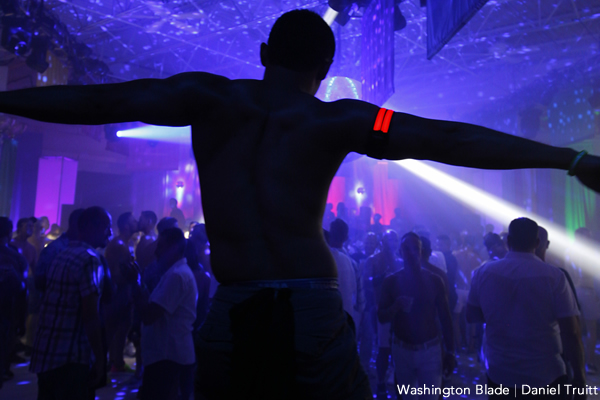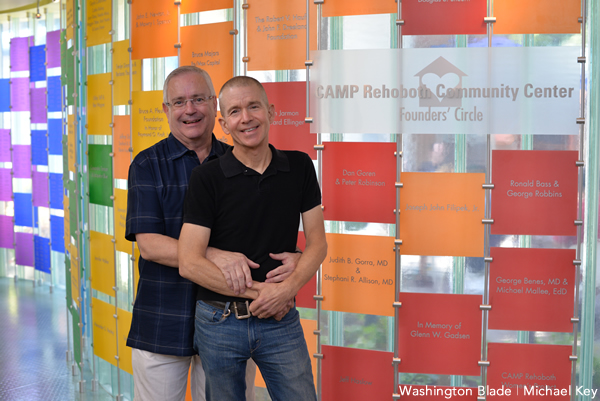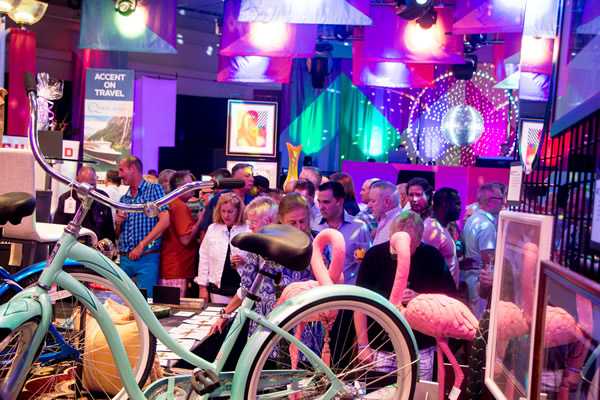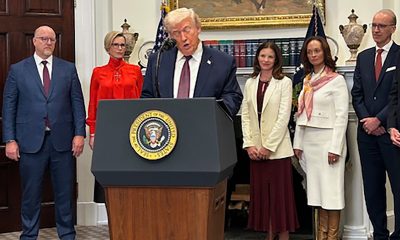a&e features
Rehoboth’s Sundance party returns this weekend
Dance, auction to be held in memory of co-founder Steve Elkins


The Sundance dance party is a Rehoboth Beach Labor Day tradition. (Washington Blade photo by Daniel Truitt)
Sundance 2018
Rainbow XXXI: In the Name of Love
Auction: Saturday, Sept. 1
7-10 p.m.
Dance: Sunday, Sept. 2
7 p.m.-2 a.m.
$80 for both events or $45 for one
Rehoboth Beach Convention Center
229 Rehoboth Ave.
Rehoboth Beach, Del.
302-227-5620
Sundance, the annual CAMP Rehoboth Labor Day weekend tradition, will be somewhat bittersweet this year.
“Sundance 2018: Rainbow XXXI: In the Name of Love” will be held this weekend to benefit CAMP Rehoboth in memory of the late Steve Elkins, who died in March from lymphoma. He was 67.

The late Steve Elkins (left) with husband Murray Archibald. The two founded Sundance more than 30 years ago. Elkins died in March. (Washington Blade file photo by Michael Key)
Sundance was created by CAMP Rehoboth founders Elkins and his husband Murray Archibald in response to the AIDS crisis in the 1980s. Archibald had been Elkins’ husband and partner for 40 years at the time of Elkins’ death. They decided to make Sundance a dance party with the purpose of raising money for AIDS charities. Archibald said in an article of a recent issue of Letters from CAMP Rehoboth that many people were dying and there was no treatment for AIDS at the time.
“It was 1988. We were losing friends left and right. We were still living in New York in those days but spending a lot of time down here,” Archibald says. “It was terrible, and we wanted to do something. It was our 10th anniversary party, Steve and mine, and everybody in our house down here wanted to do something. And I said, well, we wanted to make it a fundraiser. We did a lot of events actually back then — dance events — so we thought that would be a great way to make money.”
The Sundance Auction will be held on Saturday, Sept. 1 with an open bar, food by Plate Catering, music by Stephen Strasser and silent and live auctions. On Sunday, Sept. 2, there will be a dance party from 7 p.m.-2 a.m. with an open bar, Joe Gauthreaux as DJ and special guest Studio 54/Saint DJ Robbie Leslie. Both events will be held at the Rehoboth Beach Convention Center.
There was no auction the first year; it was added the second year. Initially, the auction happened right before the dance, but a couple years later, the auction and dance were separated into different events. Sundance has always been held on Labor Day weekend and has become a tradition.
Sundance has received an increasing amount of support and sponsorship over the years, raising more than $2 million overall.
“It’s grown. It just keeps growing. It has for years,” Archibald says. “We have tremendous community support for it. I think its growth is probably the main thing and the support that it gets. The way we’ve raised money has changed. For a good while, it was only AIDS work, and a lot of it went to Sussex County AIDS Council and helped them stay afloat.”
Archibald says when CAMP got started, its volunteers quickly began expanding AIDS services they were doing and started splitting the money raised from Sundance between CAMP and the Sussex County AIDS Council. By the time the Sussex County AIDS Council closed, CAMP was doing a lot of AIDS work and other kinds of health-related work. The money raised from Sundance has been used for CAMP Rehoboth for years now. Archibald said Sundance raised $6,000 its first year and now raises around $120,000-125,000 per year.
Elkins and Archibald have advocated for LGBT rights in Rehoboth for decades. There was tension between the gay and straight communities in the late ‘80s into the early ‘90s, with one group in town that started a campaign with bumper stickers that read, “Keep Rehoboth A Family Town.” In response, Elkins and Archibald decided to open CAMP Rehoboth, looking to promote inclusion for all.
“During the ‘80s, Rehoboth had grown tremendously as a gay resort. Gay people had been coming here for a long time,” Archibald says. “During that time, there was the Strand, which was controversial because of its location. It was open for seven years. It was a huge club. The Renegade was just outside of town. Those were two big dance clubs, and we had people coming, the crowds had gotten bigger. Everything had changed in that decade.”
Elkins and Archibald wanted to ease stress and build bridges. They developed CAMP Rehoboth with the mindset that it would work within the community, making the decision to not be “in your face” or “radical.” They wanted to work with people. Elkins and Archibald started using the language of making Rehoboth a place with “room for all.” Archibald said that when Elkins died earlier this year, the press was using that language to describe CAMP Rehoboth, showing that it worked.
The influence that Elkins and Archibald have had over the years can be seen on a statewide level, with then-Gov. Jack Markell adding sexual orientation to Delaware’s anti-discrimination law in 2009, which was signed by Markell at CAMP Rehoboth on Elkins’ birthday. Additionally, Elkins and the current president of the CAMP Rehoboth Board of Directors, Chris Beagle, testified in support of the legalization of civil unions in Delaware in 2011.
On July 1, 2013, Beagle and his husband, Eric Engelhart, decided to have their wedding ceremony at the CAMP Rehoboth Community Center because they wanted to make the occasion a celebration for the entire community. Beagle and Engelhart were selected to be the first same-sex couple to marry in Sussex County by then Sussex County Justice of the Peace, John Brady, after the legalization of same-sex marriage in Delaware.
“I gave several press interviews immediately after Steve’s passing in March, and in virtually every one of them I mentioned that I’ve had many proud moments representing CAMP Rehoboth over the years here on the board,” Beagle says. “Next to marrying my husband, Eric Engelhart, on the stage of the CAMP Community Center on July 1, 2013, my other proudest moment was testifying with Steve Elkins for the civil union legislation in 2011. He was a mentor to me in many ways, and he will always have a very special place in my heart for the leadership and difference he made in my life, and countless others. So many of us wouldn’t enjoy the life we have here today, and the protections we’re entitled too, if not for Steve Elkins and Murray Archibald.”
Beagle began volunteering for Sundance in 2006, making this his 13th year helping put it together. He has mostly worked with the decor crew and set-up team, along with Archibald and other key volunteers, many of whom have been helping Archibald for 20 years or more. Beagle also co-founded the Sundance 5k in 2010.
“It amazes us every year how Murray is able to create a visual masterpiece celebrating the particular theme of the year,” Beagle says. “A true camaraderie has evolved over these many years, and it has become a type of family reunion for many of us, something we all cherish very much. And nothing beats the sense of gratification we all share as the auction doors open at 7 p.m. The crowds start pouring in and we see the look of awe and amazement in their faces. At that moment, we know we’ve done good work.”
Natalie Moss began volunteering at CAMP Rehoboth in 1991. Moss has served as treasurer for both CAMP Rehoboth and the CAMP Rehoboth Community Center Project. She is also auction co-chair of Sundance and has been helping with the event for 28 years.
“We send out letters to all the businesses and ask them for donations. Then, we have callers and picker uppers that follow up on the letters and run around town to pick the stuff up,” Moss says. “We have a lot of individual people, as well as businesses, that give us stuff.”
Once the donations for the auction are brought to CAMP, Moss goes through them and lists them on spreadsheets. Once that’s done, the donations are brought over to the convention center where another team of volunteers displays them on the floor. Moss oversees the team that tallies the auction sheets. CAMP made the decision to use old-fashioned bid sheets because they want people to enjoy themselves and to not take away from their experience by them looking at their phones trying to bid on something.
“We get some really, really fun stuff. A lot of quirky things, games, books, glassware,” Moss says. “And the businesses give us gift certificates to restaurants — gift certificates for dinners and lunches and breakfast. Once it’s displayed, it looks beautiful.”
The Sundance auction will also have artwork, jewelry and a 60-inch TV among other things that will be up for bid. Moss says Sundance all comes together with the help of about 200 volunteers and the result has the appearance of a “fabulous-looking disco.”

The Sundance auction started 30 years ago. Organizers have intentionally kept it low tech — all the bidding takes place with paper and pen. (Photo courtesy CAMP Rehoboth)
Moss says working with Elkins was great and that everyone on the Sundance team had their role. She said Elkins did a lot behind the scenes. Elkins would run out and get whatever the Sundance team needed. He would negotiate with the liquor store to get more tonic and mixes, order lunches, pick up the lunches and did some computer work, which included printing pictures for the live auction. Moss said Elkins did everything to make sure the volunteers were taken care of.
“I used to be down here a lot, like I am now, and I’d have the music on. He was a very good singer, he had a very good voice. He used to sing in church. He would come down here and sing to me all the time, so I miss that,” Moss says. “So, Murray came in the other day. I said, ‘Are you going to sing to me?’ and he said, ‘No, you don’t want me to sing to you.’”
Monica Parr, who serves as CAMP Rehoboth’s administrative coordinator, is helping organize Sundance for her fourth year. She is managing the volunteers needed for the front-end production. Parr is working alongside Archibald taking over some of Elkins’ tasks.
“It was a joy to work with Steve. I knew Steve Elkins and Murray Archibald long before I began working at CAMP Rehoboth. I was a volunteer for Sundance almost from the beginning,” Parr says. “Steve was one of a kind. He was the kindest and most generous man you would ever meet. He would make sure that everyone felt welcome at CAMP, and at any event that CAMP Rehoboth sponsored. He will be truly missed.”
a&e features
Queer highlights of the 2026 Critics Choice Awards: Aunt Gladys, that ‘Heated Rivalry’ shoutout and more
Amy Madigan’s win in the supporting actress category puts her in serious contention to win the Oscar for ‘Weapons’

From Chelsea Handler shouting out Heated Rivalry in her opening monologue to Amy Madigan proving that horror performances can (and should) be taken seriously, the Critics Choice Awards provided plenty of iconic moments for queer movie fans to celebrate on the long road to Oscar night.
Handler kicked off the ceremony by recapping the biggest moments in pop culture last year, from Wicked: For Good to Sinners. She also made room to joke about the surprise hit TV sensation on everyone’s minds: “Shoutout to Heated Rivalry. Everyone loves it! Gay men love it, women love it, straight men who say they aren’t gay but work out at Equinox love it!”
The back-to-back wins for Jacob Elordi in Frankenstein and Amy Madigan in Weapons are notable, given the horror bias that awards voters typically have. Aunt Gladys instantly became a pop culture phenomenon within the LGBTQ+ community when Zach Cregger’s hit horror comedy released in August, but the thought that Madigan could be a serious awards contender for such a fun, out-there performance seemed improbable to most months ago. Now, considering the sheer amount of critics’ attention she’s received over the past month, there’s no denying she’s in the running for the Oscar.
“I really wasn’t expecting all of this because I thought people would like the movie, and I thought people would dig Gladys, but you love Gladys! I mean, it’s crazy,” Madigan said during her acceptance speech. “I get [sent] makeup tutorials and paintings. I even got one weird thing about how she’s a sex icon also, which I didn’t go too deep into that one.”
Over on the TV side, Rhea Seehorn won in the incredibly competitive best actress in a drama series category for her acclaimed performance as Carol in Pluribus, beating out the likes of Emmy winner Britt Lower for Severance, Carrie Coon for The White Lotus, and Bella Ramsey for The Last of Us. Pluribus, which was created by Breaking Bad’s showrunner Vince Gilligan, has been celebrated by audiences for its rich exploration of queer trauma and conversion therapy.
Jean Smart was Hack’s only win of the night, as Hannah Einbinder couldn’t repeat her Emmy victory in the supporting actress in a comedy series category against Janelle James, who nabbed a trophy for Abbott Elementary. Hacks lost the best comedy series award to The Studio, as it did at the Emmys in September. And in the limited series category, Erin Doherty repeated her Emmy success in supporting actress, joining in yet another Adolescence awards sweep.
As Oscar fans speculate on what these Critics Choice wins mean for future ceremonies, we have next week’s Golden Globes ceremony to look forward to on Jan. 11.
a&e features
Looking back at the 10 biggest A&E stories of 2025
‘Wicked,’ Lady Gaga’s new era, ‘Sexy’ Bailey and more

Although 2025 was a year marked by countless attacks on trans rights and political setbacks, the year also saw brilliant queer artists continuing to create art. From Cannes and Sundance Award winners now vying for Oscar consideration to pop icons entering new stages of their careers, queer people persevered to tell their stories through different media.
With the state of the world so uncertain, perhaps there’s no more vital time to celebrate our wins, as seen through some of this year’s top pop culture moments. While there’s no collection of 10 stories that fully encompass “the most important” news, here are some events that got the gays going:
10. ‘Mysterious Gaze of the Flamingo’ wins big at Cannes

The Cannes Film Festival has become a crucial start for films hoping to make their way to the Oscars, and first-time director Diego Céspedes won the top Un Certain Regard prize for his intimate western “The Mysterious Gaze of the Flamingo.” The film is set in the ‘80s and is intended as an allegory for the AIDS epidemic. Seeing a film that unpacks vital queer history win one of the most coveted awards at Cannes has been a huge point of pride in the independent filmmaking community.
Since the film bowed at Cannes, it has been selected as Chile’s Oscar entry in the Best International Feature race. Speaking with The Blade during the film’s AFI Fest run in October, Céspedes said: At first, I was kind of scared to have this campaign position in the times that we’re living [in] here. But at the same time, I think the Oscars mean a huge platform — a huge platform for art and politics.”
9. ‘The Last of Us’ returns for an even gayer season 2
While the first season of The Last of Us gave us one of TV’s most heartbreaking queer love stories in the episode “Long, Long Time,” Season 2 doubled down on its commitment to queer storytelling with the blossoming relationship between Ellie (Bella Ramsey) and Dina (Isabela Merced). The show expanded on the pair’s relationship in the original video game, making it perhaps the central dynamic to the entire season. That unfortunately came with more homophobic backlash on the internet, but those who checked out all the episodes saw a tender relationship form amid the show’s post-apocalyptic, often violent backdrop. For their performance, Ramsey was once again nominated for an Emmy, but Merced deserved just as much awards attention.
8. ‘Emilia Pérez’ sparks controversy
Jacques Audiard’s genre-bending trans musical “Emilia Pérez” proved to be an awards season juggernaut this time last year, winning the Golden Globe for Best Musical/Comedy. But when the lead star Karla Sofia Gascón’s racist, sexist, and homophobic old tweets resurfaced, the film’s Oscar campaign became a tough sell, especially after Netflix had tried so hard to sell Emilia Pérez as the “progressive” film to vote for. Mind you, the film had already received significant backlash from LGBTQ+ audiences and the Mexican community for its stereotypical and reductive portrayals, but the Gascón controversy made what was originally just social media backlash impossible to ignore. The only person who seemed to come out of the whole debacle unscathed was Zoe Saldaña, who won the Oscar for Best Supporting Actress over Ariana Grande.
7. ‘Sorry, Baby’ establishes Eva Victor as major talent
Back in January at the Sundance Film Festival, Eva Victor (known by many for her brand of sketch comedy) premiered their directorial debut “Sorry, Baby” to rave reviews, even winning the Waldo Salt Screening Award. Victor shadowed Jane Schoenbrun on the set of “I Saw the TV Glow,” and seeing Victor come into their own and establish such a strong voice immediately made them one of independent cinema’s most exciting new voices. A memorable scene in the film sees the main character, Agnes (played by Victor), struggling to check a box for male or female, just one example of how naturally queerness is woven into the fabric of the story.
Most recently, Victor was nominated for a Golden Globe for her performance in the film, and she’s represented in a category alongside Jennifer Lawrence (“Die My Love”), Jessie Buckley (“Hamnet”), Julia Roberts (“After the Hunt”), Renate Reinsve (“Sentimental Value”) and Tessa Thompson (“Hedda”). The film also received four Independent Spirit Award nominations overall.
6. Paul Reubens comes out in posthumous doc

While Paul Reubens never publicly came out as gay before passing away in 2023, the two-part documentary “Pee-wee as Himself” premiered back in May on HBO Max, giving the legendary comedian a chance to posthumously open up to the world. Directed by Matt Wolf, the documentary explores how Reubens found his alter ego Pee-Wee Herman and why he kept his private life private.
The documentary won an Emmy in the Outstanding Documentary or Nonfiction Special category and remains one of the most critically acclaimed titles of the year with a 100% Rotten Tomatoes score. Also worth noting, the National Geographic documentary Sally told the posthumous coming out story of Sally Ride through the help of her long-time partner, Tam O’Shaughnessy.
5. Lady Gaga releases ‘Mayhem’
Lady Gaga entered a new phase of her musical career with the release of Mayhem, her seventh album to date. From the frenzy-inducing pop hit Abracadabra to the memorable Bruno Mars duet featured on “Die With a Smile,” seeing Gaga return to her roots and make an album for the most die-hard of fans was especially rewarding after the underwhelming film releases of “House of Gucci” and “Joker: Folie à Deux.” Gaga has been touring with The Mayhem Ball since July, her first arena tour since 2018. She even extended her tour into 2026 with more North American dates, so the party isn’t stopping anytime soon. And Gaga is even set to make an appearance next May in “The Devil Wears Prada 2.”
4. Cynthia Erivo, Ariana Grande perform at the Oscars

While “Wicked: For Good” didn’t quite reach the heights of the first film, we will forever have Cynthia Erivo and Ariana Grande’s breathtaking live performance that opened the 97th Academy Awards. The pair sang a rendition of “Over the Rainbow,” “Home,” and “Defying Gravity,” paying proper homage to the original 1939 “Wizard of Oz.” Even non-Wicked fans can’t deny how magical and brilliantly staged this performance was. With both Erivo and Grande up for acting Oscars last year, they’re hoping to repeat success and make history with consecutive nominations. Either way, let’s hope there’s another live performance in the making, especially with two new original songs (The Girl in the Bubble and No Place Like Home) in the mix.
3. Indya Moore speaks out against Ryan Murphy
Indya Moore has consistently used social media as a platform for activism, and in September, posted a 30-minute Instagram live speaking out against “Pose” co-creator Ryan Murphy. Moore claimed that Murphy wasn’t being a true activist for trans people. “Ryan Murphy, we need you to do more. You need to address the racism, the violence, and the targeting of people on your productions, Ryan Murphy. You do need to make sure trans people are paid equally. Yes, Janet did the right thing,” Moore said. Murphy was also back in the headlines this year for the critically panned “All’s Fair” and the controversial “Monster: The Ed Gein Story” starring Laurie Metcalf and Charlie Hunnam.
2. Cole Escola wins Tony for Best Leading Actor
Few pop culture moments this year brought us together more than Cole Escola winning a Tony award for “Oh, Mary!” the Broadway show they created, wrote and starred in (we love a triple threat!) Escola made history by becoming the first nonbinary person to win a Tony in the leading actor category, and seeing them excitedly rush to the stage wearing a Bernadette Peters-inspired gown instantly became a viral social media moment.
The cherry on top of Escola’s major moment is the recent news that they are writing a Miss Piggy movie with Jennifer Lawrence and Emma Stone producing — news that also broke the internet for the better. We cannot wait!
1. Jonathan Bailey makes gay history as ‘Sexiest Man Alive’

The same year as his on-screen roles in blockbusters “Jurassic World Rebirth” and “Wicked: For Good,” Jonathan Bailey made history as the first openly gay man to be named People magazine’s “Sexiest Man Alive.” The fact that it took 40 years for an openly gay man to earn the title is a signifier of how far we still have to go with queer representation, and seeing Bailey celebrated is just one small step in the right direction.
“There’s so many people that want to do brilliant stuff who feel like they can’t,” he told PEOPLE, “and I know the LGBT sector is under immense threat at the moment. So it’s been amazing to meet people who have the expertise and see potential that I could have only dreamed of.” In 2024, Bailey founded the charity titled The Shameless Fund, which raises money for LGBTQ+ organizations.
a&e features
Your guide to D.C.’s queer New Year’s Eve parties
Ring in 2026 with drag, leather, Champagne, and more

With Christmas in the rear view mirror, we can turn our attention to ringing in a much-anticipated New Year with a slew of local LGBTQ parties. Here’s what’s on tap.
Pitchers
This spacious Adams Morgan bar is hosting the “Pitchers’ Perfect New Year’s Eve.” There will be a midnight Champagne toast, the ball drop on the big screens, and no cover, all night long. The bar doesn’t close until 4 a.m., and the kitchen will be open late (though not until close). All five floors will be open for the party, and party favors are promised.
Trade
D.C.’s hottest bar/club combo is leaning into the Shark motif with its NYE party, “Feeding Frenzy.” The party is a “glitterati-infused Naughty-cal New Year’s Even in the Shark Tank, where the boats are churning and the sharks are circling.” Trade also boasts no cover charge, with doors opening at 5 p.m. and the aforementioned Shark Tank opening at 9 p.m.. Four DJs will be spread across the two spaces; midnight hostess is played by Vagenesis and the two sea sirens sensuously calling are Anathema and Justin Williams.
Number Nine
While Trade will have two DJs as part of one party, Number Nine will host two separate parties, one on each floor. The first floor is classic Number Nine, a more casual-style event with the countdown on TVs and a Champagne midnight toast. There will be no cover and doors open at 5 p.m. Upstairs will be hosted by Capital Sapphics for its second annual NYE gathering. Tickets (about $50) include a midnight Champagne toast, curated drink menu, sapphic DJ set by Rijak, and tarot readings by Yooji.
Crush
Crush will kick off NYE with a free drag bingo at 8 p.m. for the early birds. Post-bingo, there will be a cover for the rest of the evening, featuring two DJs. The cover ($20 limited pre-sale that includes line skip until 11 p.m.; $25 at the door after 9 p.m.) includes one free N/A or Crush, a Champagne toast, and party favors (“the legal kind”). More details on Eventbrite.
Bunker
This subterranean lair is hosting a NYE party entitled “Frosted & Fur: Aspen After Dark New Year’s Eve Celebration.” Arriety from Rupaul Season 15 is set to host, with International DJ Alex Lo. Doors open at 9 p.m. and close at 3 p.m.; there is a midnight Champagne toast. Cover is $25, plus an optional $99 all-you-can-drink package.
District Eagle
This leather-focused bar is hosting “Bulge” for its NYE party. Each District Eagle floor will have its own music and vibe. Doors run from 7 p.m.-3 a.m. and cover is $15. There will be a Champagne toast at midnight, as well as drink specials during the event.
Kiki, Shakiki
Kiki and its new sister bar program Shakiki (in the old Shakers space) will have the same type of party on New Year’s Eve. Both bars open their doors at 5 p.m. and stay open until closing time. Both will offer a Champagne toast at midnight. At Kiki, DJ Vodkatrina will play; at Shakiki, it’ll be DJ Alex Love. Kiki keeps the party going on New Year’s Day, opening at 2 p.m., to celebrate Kiki’s fourth anniversary. There will be a drag show at 6 p.m. and an early 2000s dance party 4-8 p.m.
Spark
This bar and its new menu of alcoholic and twin N/A drinks will host a NYE party with music by DJ Emerald Fox. Given this menu, there will be a complimentary toast at midnight, guests can choose either sparkling wine with or without alcohol. No cover, but Spark is also offering optional wristbands at the door for $35 open bar 11 p.m.-1 a.m. (mid-shelf liquor & all NA drinks).




















